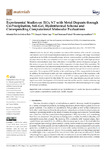Mostrar o rexistro simple do ítem
Experimental studies on TiO2 NT with metal dopants through co-precipitation, sol–gel, hydrothermal scheme and corresponding computational molecular evaluations
| dc.contributor.author | Estévez Ruiz, Eduardo Patricio | |
| dc.contributor.author | López, Joaquín | |
| dc.contributor.author | Thirumuruganandham, Saravana Prakash | |
| dc.date.accessioned | 2023-05-18T08:04:58Z | |
| dc.date.available | 2023-05-18T08:04:58Z | |
| dc.date.issued | 2023-04-13 | |
| dc.identifier.citation | Estévez Ruiz, E.P.; López Lago, J.; Thirumuruganandham, S.P. Experimental Studies on TiO2 NT with Metal Dopants through Co-Precipitation, Sol–Gel, Hydrothermal Scheme and Corresponding Computational Molecular Evaluations. Materials 2023, 16, 3076. https://doi.org/10.3390/ma16083076 | es_ES |
| dc.identifier.issn | 1996-1944 | |
| dc.identifier.uri | http://hdl.handle.net/2183/33085 | |
| dc.description.abstract | [Abstract] In the last decade, TiO2 nanotubes have attracted the attention of the scientific community and industry due to their exceptional photocatalytic properties, opening a wide range of additional applications in the fields of renewable energy, sensors, supercapacitors, and the pharmaceutical industry. However, their use is limited because their band gap is tied to the visible light spectrum. Therefore, it is essential to dope them with metals to extend their physicochemical advantages. In this review, we provide a brief overview of the preparation of metal-doped TiO2 nanotubes. We address hydrothermal and alteration methods that have been used to study the effects of different metal dopants on the structural, morphological, and optoelectrical properties of anatase and rutile nanotubes. The progress of DFT studies on the metal doping of TiO2 nanoparticles is discussed. In addition, the traditional models and their confirmation of the results of the experiment with TiO2 nanotubes are reviewed, as well as the use of TNT in various applications and the future prospects for its development in other fields. We focus on the comprehensive analysis and practical significance of the development of TiO2 hybrid materials and the need for a better understanding of the structural–chemical properties of anatase TiO2 nanotubes with metal doping for ion storage devices such as batteries. | es_ES |
| dc.description.sponsorship | Ecuador. Universidad Indoamérica; INV-0014-03-011 | es_ES |
| dc.language.iso | eng | es_ES |
| dc.publisher | MDPI | es_ES |
| dc.relation.uri | https://doi.org/10.3390/ma16083076 | es_ES |
| dc.rights | Creative Commons Attribution (CC BY) license https://creativecommons.org/licenses/by/4.0/ | es_ES |
| dc.rights.uri | http://creativecommons.org/licenses/by/3.0/es/ | * |
| dc.subject | Rutile and anatase nanotube | es_ES |
| dc.subject | Sol–gel | es_ES |
| dc.subject | Hydrothermal | es_ES |
| dc.subject | DFT | es_ES |
| dc.subject | Molecular dynamics | es_ES |
| dc.subject | Synthesis | es_ES |
| dc.subject | Co-precipitation | es_ES |
| dc.subject | Nanobatteries | es_ES |
| dc.subject | Metal oxide | es_ES |
| dc.subject | Metallic dopants | es_ES |
| dc.title | Experimental studies on TiO2 NT with metal dopants through co-precipitation, sol–gel, hydrothermal scheme and corresponding computational molecular evaluations | es_ES |
| dc.type | info:eu-repo/semantics/article | es_ES |
| dc.rights.access | info:eu-repo/semantics/openAccess | es_ES |
| UDC.journalTitle | Materials | es_ES |
| UDC.volume | 16 | es_ES |
| UDC.issue | 8 | es_ES |
| UDC.startPage | 1 | es_ES |
| UDC.endPage | 34 | es_ES |
| dc.identifier.doi | https://doi.org/10.3390/ma16083076 |






